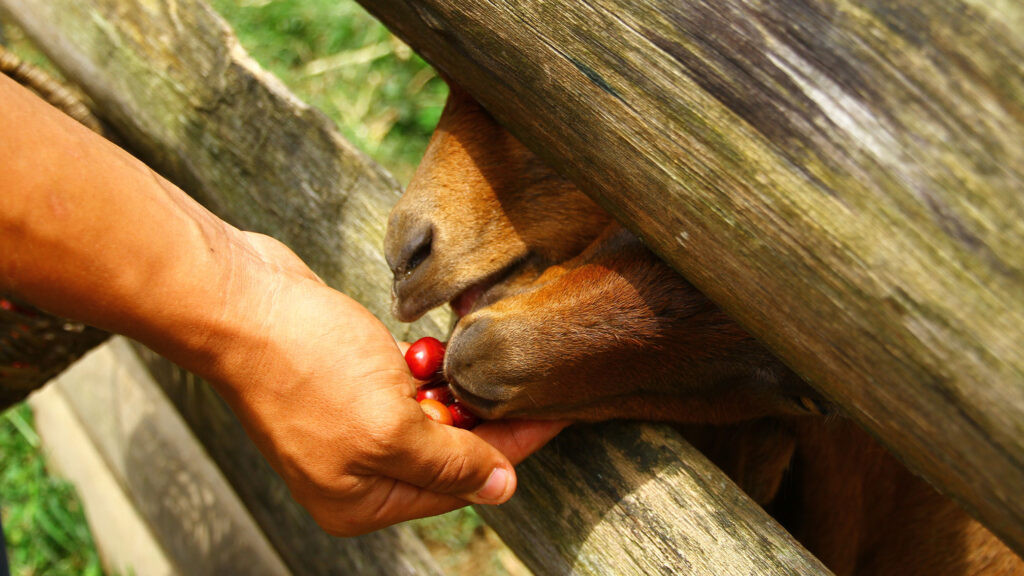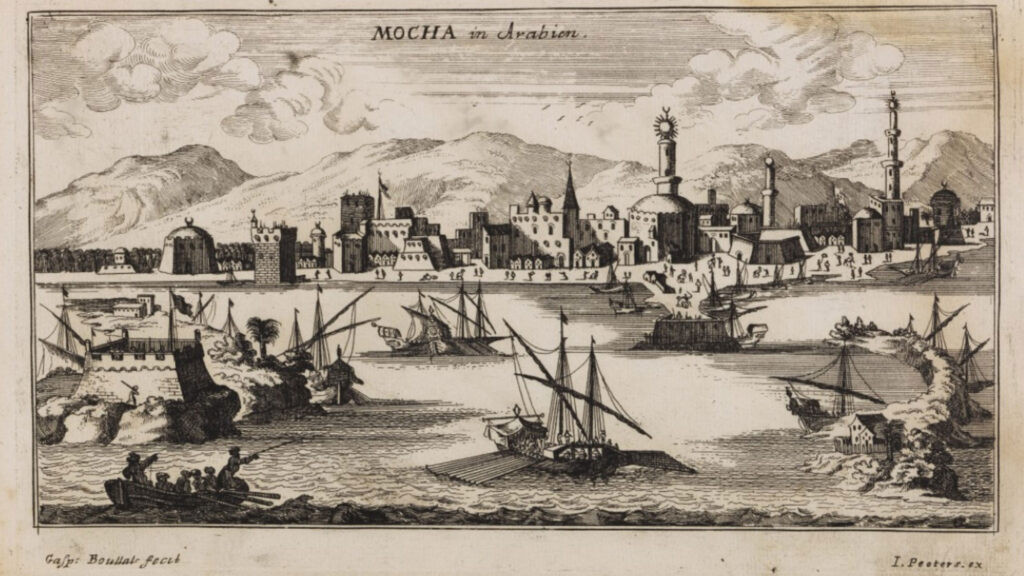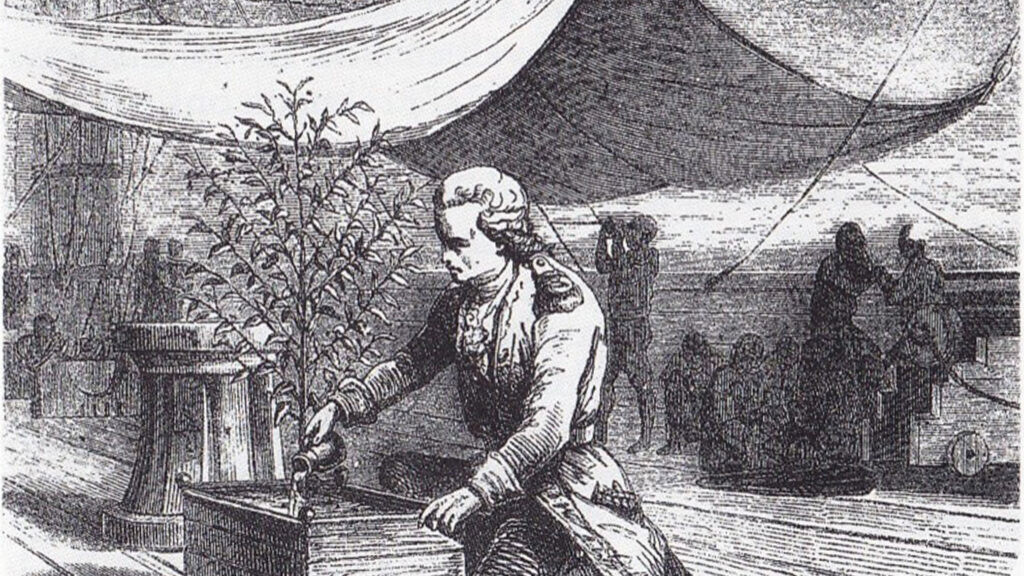The story of coffee’s beginnings is shrouded in a delightful mystery, much like the enticing aroma that wafts from a freshly brewed cup. While no official documents pinpoint the exact moment of coffee tree discovery or the invention of coffee as the beloved beverage we know today, captivating legends and historical accounts weave together a rich tapestry of coffee’s journey across the globe. Let’s embark on an exploration to uncover where coffee originated and how it journeyed from its humble beginnings to become a global phenomenon.
9th Century: Innovation on the Ethiopian Plateau
Legend has it that coffee’s stimulating properties were first recognized by an Ethiopian goat herder named Kaldi during the 9th century. As the story goes, Kaldi observed his goats behaving unusually energetic after they consumed the bright red cherries from a particular tree growing in the highlands of the Ethiopian plateau. These goats, normally ready to rest, were now prancing about, full of vigor and showing no desire to sleep even as night fell.
Intrigued by this peculiar effect, Kaldi shared his observation with the abbot of a nearby monastery. The abbot, struggling to maintain alertness during long evening prayers, decided to investigate these curious berries. He prepared a drink using the cherries and discovered, much to his delight, that it helped him stay awake and focused. Thus, according to folklore, the invention of coffee was born out of a very relatable need – to combat sleepiness.
This energizing drink, initially shared among the monks to aid their spiritual practices, soon began to spread beyond the monastery walls, eastward and outwards, carrying with it the secret of these invigorating berries.
 Goats discovered coffee cherries in Ethiopia, according to legend.
Goats discovered coffee cherries in Ethiopia, according to legend.
15th-16th Centuries: Coffee Culture Develops on the Arabian Peninsula
The commercial narrative of coffee history takes root in the Arabian Peninsula, where the cultivation and trade of coffee first flourished. By the 15th century, coffee cultivation was established in present-day Yemen. During the 16th century, coffee’s popularity surged across regions now known as Iran, Egypt, Syria, and Turkey, marking the beginning of a widespread coffee culture.
Wisdom in a cup
During this era, coffee consumption extended beyond private homes and into public life with the emergence of qahveh khaneh, or coffee houses, in cities throughout the Middle East. These vibrant social hubs were more than just places to enjoy a cup of coffee. They were centers of social interaction, intellectual discourse, and entertainment. Patrons could engage in conversations, listen to music, watch performances, play chess, and stay informed about current events. Such was their role in the dissemination of knowledge and ideas that coffee houses earned the moniker “Schools of the Wise,” highlighting their importance in the exchange of information and fostering intellectual growth.
The Arabian Peninsula, a crossroads of trade and pilgrimage, attracted travelers from far and wide, including those journeying to Mecca. As these pilgrims returned to their homes, they carried with them tales of the enchanting coffee houses and the stimulating “wine of Araby,” further spreading awareness and desire for coffee.
 Historic coffee shop in Cairo, reflecting early coffee house culture in the Middle East.
Historic coffee shop in Cairo, reflecting early coffee house culture in the Middle East.
17th Century: Growth of Coffee Consumption in Europe
The 17th century witnessed coffee’s arrival and burgeoning popularity in Europe, transforming the continent’s social and economic landscape.
A threat and a triumph
Coffee’s introduction to Europe was not without resistance. Initially, it was met with suspicion and apprehension, even being labeled the “bitter invention of Satan” by some. When coffee first appeared in Venice in 1615, local clergy condemned it, leading to a significant controversy that required papal intervention. Pope Clement VIII, intrigued by the debate, decided to taste coffee for himself. Impressed by its flavor and invigorating effects, he declared it acceptable, effectively granting it papal approval and paving the way for its wider acceptance.
Penny universities
Despite initial skepticism, coffee houses rapidly proliferated across major European cities including London, Vienna, Paris, and Hamburg, mirroring the social function of the qahveh khaneh. In England, these establishments became known as “penny universities.” For the price of a penny – the cost of a cup of coffee – patrons could engage in stimulating conversations on a wide array of topics, fostering intellectual exchange and debate.
Coffee at work
Prior to coffee’s widespread availability, beer and wine were common breakfast beverages, hardly conducive to focus or productivity. As coffee gained traction, it began to replace these alcoholic drinks as the morning beverage of choice. People discovered that coffee enhanced alertness and energy levels, leading to improved work quality and efficiency. Coffee’s role in boosting productivity has been instrumental for centuries, supporting the workforce and driving economic activity.
Early business incubators
By the mid-17th century, London alone boasted over 300 coffee houses, many of which evolved into specialized hubs catering to specific clientele. Merchants, artists, brokers, and other professionals congregated in coffee houses that aligned with their interests and professions. These specialized coffee houses even became breeding grounds for businesses. A prime example is Lloyd’s of London, the globally recognized insurance marketplace, which originated from Edward Lloyd’s Coffee House, demonstrating the significant role coffee houses played in early business development.
 17th-century London coffee house interior, a hub for social interaction and intellectual exchange.
17th-century London coffee house interior, a hub for social interaction and intellectual exchange.
17th Century: Rise of Coffee Plantations in Asia
The escalating global demand for coffee fueled intense competition to cultivate coffee outside of Arabia.
The Dutch finally managed to acquire coffee tree seedlings in the latter part of the 17th century. Initial attempts to cultivate them in India proved unsuccessful, but they achieved success in present-day Indonesia, on the island of Java. The coffee trees thrived in the Indonesian climate, leading to a productive and expanding coffee trade for the Dutch. They subsequently extended coffee cultivation to the islands of Sumatra and Sulawesi, establishing a significant foothold in coffee production.
The Dutch also innovated by creating the world’s first coffee blend in Indonesia, combining Arabian coffee (Mocha), named after the Yemeni port city of Mocha, with Javanese coffee. This blend, known as Mocha Java, remains popular today, showcasing the enduring legacy of early coffee innovation.
Nearly two centuries later, French missionaries introduced coffee trees to Vietnam, bringing Arabica varieties from the island of Bourbon and planting them around Tonkin in the mid-19th century, further expanding coffee’s cultivation in Asia.
 Historic Port of Mocha, Yemen, a key location in early coffee trade and the origin of Mocha coffee.
Historic Port of Mocha, Yemen, a key location in early coffee trade and the origin of Mocha coffee.
18th Century: The Seed is Planted for Coffee in the Americas
In 1714, the Mayor of Amsterdam gifted a young coffee tree to King Louis XIV of France. The King ordered it to be planted in the Royal Botanical Garden in Paris. In 1723, Gabriel de Clieu, a young naval officer, ingeniously obtained a seedling from the King’s prized tree. Despite a perilous voyage marked by severe weather, a pirate attack, and even an act of sabotage aimed at destroying the seedling, de Clieu successfully transported it to Martinique in the Caribbean.
Small seedling, enormous impact
Once planted in Martinique, the seedling flourished, becoming the progenitor of coffee cultivation throughout the Americas. Over the next half-century, Martinique alone cultivated over 18 million coffee trees, all descendants of this single seedling. Furthermore, it served as the source for the first coffee trees in the Caribbean, as well as South and Central America, underscoring the monumental impact of this one resilient plant.
Born from a bouquet
Coffee’s arrival in Brazil is attributed to the resourcefulness and charm of Francisco de Mello Palheta, a Portuguese military officer dispatched to French Guiana to procure coffee seedlings. The French, fiercely protective of their coffee holdings, were unwilling to share. However, de Mello Palheta’s charm proved effective. The French Governor’s wife, captivated by him, presented him with a large bouquet of flowers as he departed. Concealed within the bouquet were enough coffee seeds to initiate what would become Brazil’s multi-billion dollar coffee industry, highlighting the intriguing and sometimes clandestine nature of coffee’s global spread.
 Gabriel De Clieu's voyage to transport coffee seedlings to Martinique, crucial for coffee's spread in the Americas.
Gabriel De Clieu's voyage to transport coffee seedlings to Martinique, crucial for coffee's spread in the Americas.
18th Century: Coffee Overtakes Tea in the New World
Coffee was introduced to New York City in the mid-1600s, and coffee houses gradually gained popularity over the subsequent century. However, tea remained the preferred beverage in the New World until King George III imposed a heavy tax on tea in 1773. This tax ignited widespread protest, culminating in the Boston Tea Party and the American Revolution. This pivotal event not only reshaped American history but also permanently shifted American beverage preference towards coffee.
 Tontine Coffee House in 18th-century New York, an early American coffee establishment.
Tontine Coffee House in 18th-century New York, an early American coffee establishment.
19th Century: One of the Most Sought-After Commodities in the World
The 19th century witnessed coffee’s continued global expansion, carried by missionaries, traders, colonists, and travelers. Coffee cultivation spread to diverse terrains, from tropical forests to mountainous highlands. While some crops thrived, others failed, reflecting the challenges and fortunes associated with coffee cultivation. New nations arose, their economies heavily reliant on coffee production, emphasizing the profound economic impact of this commodity.
By the dawn of the 19th century, coffee had solidified its position as one of the world’s most profitable export crops, becoming the second most sought-after commodity globally, surpassed only by crude oil. Coffee’s central role in global society was firmly established, a position it maintains to this day.
 19th-century industrial coffee roasting, illustrating coffee's rise as a major global commodity.
19th-century industrial coffee roasting, illustrating coffee's rise as a major global commodity.
20th-21st Centuries: Growing the Coffee Community in the U.S.
Coffee consumption and culture have continued to evolve throughout the 20th and 21st centuries. We have witnessed distinct “waves” of coffee, each representing a specific type of coffee and a shift in coffee culture. The first wave, driven by industrialization, brought mass-produced, pre-ground coffee to grocery store shelves, prioritizing convenience and functionality. Origin and nuanced flavors were largely overlooked during this period.
The second wave emerged with the rise of coffee chains and brands, now ubiquitous globally. These modern coffee shops, echoing historical coffee houses, emphasized not just coffee quality but also the overall coffee experience. They fostered a culture of experimentation with diverse coffee types, drinks, and flavors.
The third wave, often termed specialty coffee, caters to increasingly sophisticated palates. It prioritizes high-quality beans, specific flavor profiles, single-origin coffees, diverse roasts, and brewing methods like pour-over and French press. Sustainability and transparency in coffee production also gained prominence. Emerging trends like ready-to-drink (RTD) coffee in cans and bottles offer further convenience, demonstrating the ongoing evolution of coffee consumption.
 Contemporary coffee shop showcasing third-wave coffee culture and specialty coffee offerings.
Contemporary coffee shop showcasing third-wave coffee culture and specialty coffee offerings.
Sippable Fact
Established in 1911, the National Coffee Association stands as one of the earliest trade associations in the U.S., highlighting the long-standing significance of coffee in American commerce and culture.
To delve deeper into coffee’s fascinating journey, explore the modern coffee-growing regions and the lifecycle of coffee to further appreciate the intricate story of this globally beloved beverage.
